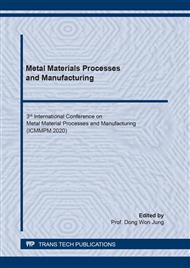p.3
p.13
p.23
p.33
p.43
p.51
p.59
p.65
Numerical Analysis of Solidification Behavior during Laser Welding Nickel-Based Single-Crystal Superalloy Part: II Crystallography-Dependent Supersaturation of Liquid Aluminum
Abstract:
The thermal metallurgical modeling of liquid aluminum supersaturation was further developed through couple of heat transfer model, dendrite selection model, multicomponent dendrite growth model and nonequilibrium solidification model during three-dimensional nickel-based single-crystal superalloy weld pool solidification. The welding configuration plays more important role in supersaturation of liquid aluminum, morphology instability and nonequilibrium partition behavior. The bimodal distribution of liquid aluminum supersaturation along the solid/liquid interface is crystallographically symmetrical about the weld pool centerline in (001) and [100] welding configuration. The distribution of liquid aluminum supersaturation along the solid/liquid interface is crystallographically asymmetrical throughout the weld pool in (001) and [110] welding configuration. Optimum low heat input (low laser power and high welding speed) with (001) and [100] welding configuration is more favored to predominantly promote epitaxial [001] dendrite growth to reduce the metallurgical factors for solidification cracking than that of high heat input (high laser power and slow welding speed) with (001) and [110] welding configuration. The lower the heat input is used, the lower supersaturation of liquid aluminum is imposed, and the smaller size of vulnerable [100] dendrite growth region is incurred to ameliorate solidification cracking susceptibility and vice versa. The overall supersaturation of liquid aluminum in (001) and [100] welding configuration is beneficially smaller than that of (001) and [110] welding configuration regardless of heat input, and is not thermodynamically relieved by gamma prime γˊ phase. (001) and [110] welding configuration is detrimental to weldability and deteriorates the solidification cracking susceptibility because of unfavorable crystallographic orientations and alloying aluminum enrichment. The mechanism of asymmetrical solidification cracking because of crystallography-dependent supersaturation of liquid aluminum is proposed. The eligible solidification cracking location is particularly confined in [100] dendrite growth region. Moreover, the theoretical predictions agree well with the experiment results. The useful modeling is also applicable to other single-crystal superalloys with similar metallurgical properties for laser welding or laser cladding. The thorough numerical analyses facilitate the understanding of weld pool solidification behavior, microstructure development and solidification cracking phenomena in the primary γ phase, and thereby optimize the welding conditions (laser power, welding speed and welding configuration) for successful crack-free laser welding.
Info:
Periodical:
Pages:
13-22
Citation:
Online since:
January 2021
Authors:
Price:
Сopyright:
© 2021 Trans Tech Publications Ltd. All Rights Reserved
Share:
Citation:


